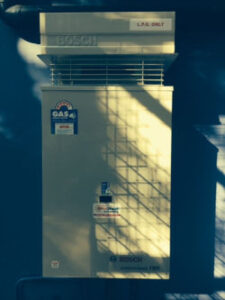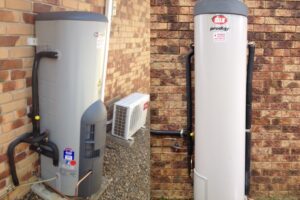As the cost of energy in Australia continues to rise, choosing energy efficient appliances has become more important than ever. And with an average of 25% of the total energy usage in Australian homes attributed to hot water usage, choosing the right hot water system for your needs is essential.
There are many different types of hot water systems including solar, heat pump, electric, and gas. Below is our general guide to choosing the best gas hot water system for your household, however, every household’s needs are different. If you need personalised advice call you local hot water specialists at Sun City hot Water & Plumbing on 1300 728 122.
Types Of Gas Hot Water Systems
There are two main types of gas hot water systems; storage and continuous flow. There are also gas boosted solar hot water systems that use a supplementary gas hot water system to heat water when the energy supply from the solar collectors is insufficient.
Storage Gas Hot Water System

Gas storage hot water systems use a gas burner to heat stored water to a preset temperature. Once the water is heated it is then stored in the tank until it is needed. There is a thermostat in the tank that monitors water temperature to ensure that it is heated to the desired temperature as well as activating the gas burner whenever the water temperature drops.
Gas storage hot water systems heat and then store the hot water which makes them less energy efficient than their tankless counterparts. This is due to the fact that heat is lost through the walls of the tank over time requiring the gas burner to frequently reignite in order to maintain the set temperature.
Additionally, a gas storage hot water heater can only heat one tank of water at a time, limiting your hot water usage to the size of the storage tank. Once a whole tank of hot water has been used there is significant downtime before your hot water will be back up and running as a new tank of water has to be heated.
Continuous Flow Gas Hot Water System

Continuous flow gas hot water systems heat the water as you use it. This makes them much more energy efficient than storage systems that store heated water and must constantly heat the water to make up for the heat that is lost through the walls of the tank.
As the name suggests, continuous flow hot water systems can maintain a continuous flow of hot water indefinitely. This is due to the fact that the water is heated on demand rather than heated by the tank full. This means that continuous flow hot water systems will never run out of hot water no matter how many showers are had in one day. However, the drawback to heating water on demand is that when multiple outlets are in use the water flow rate is reduced.
Additionally, continuous flow gas hot water systems can be used with both natural and LPG gas.
Gas Boosted Solar Hot Water Heaters
Gas boosted solar hot water systems are solar hot water systems that have a supplementary continuous flow gas hot water system. The tankless system is essentially a small continuous flow gas hot water system that heats hot water in exactly the same way as other continuous flow systems.
The gas booster in a solar hot water system is only used when the energy collected from the sun is insufficient for heating the required amount of water. (For example, on a particularly cloudy day where there is minimal sun and therefore, minimal energy to harvest).
How Do They Work?
Storage Gas Hot Water System

Storage gas hot water systems are made up of four main components:
- Pilot Flame
- Gas Burner
- Storage Tank
- Thermostat
Cold water from the main water supply is circulated into the storage tank through a pipe in near the base of the tank. The pilot flame and gas burner are located at the base of the hot water system. The continuously burning pilot flame is used to ignite the gas burner whenever the thermostat detects that the water temperature in the tank is below the set water temperature.
Heat is transferred from the gas burner through the bottom of the tank in order to heat the water inside. As the water is heated it rises to the top of the tank. Hot water is drawn from the top of the tank when a hot water outlet is in use. This ensures that the cold water that is pumped into the bottom of the tank to top up the water level is not sent straight back out to an outlet.
Storage gas hot water systems generally have an adjustable thermostat at the base of the system in order to allow the user to set the desired temperature. Gas storage hot water systems will also generally have a flue going through the middle of the tank in order to vent exhaust gas. The heat of the exhaust gas also helps to heat the water in the tank as heat is transferred from the hot flue to the surrounding water.
Continuous Flow Gas Hot Water System

Continuous flow gas hot water systems are made with three main components:
- Flow Sensor
- Gas Burner
- Heat Exchanger
- Electric Control Unit (ECU)
In a continuous flow gas hot water system the flow sensor detects when a hot water outlet is turned on which then activates the gas burner. Once the gas burner is activated the heat from the burner heats the coiled pipes of the heat exchanger. The water is slowed as it is pumped through the pipes of the heat exchanger allowing heat to transfer from the pipes to the water.
The ECU modulates the gas burner to ensure that the preset water temperature is maintained.
Gas Boosted Solar Hot water System
The gas component of a gas boosted hot water system works in exactly the same way as a continuous flow gas hot water system. When the energy collected by the solar collectors is insufficient to heat the water to the preset temperature water is redirected into the gas booster.
The water flows through the heat exchanger, activating the gas burner. The gas burner then heats the pipes of the heat exchanger which transfers the heat from the pipes to the water. Once the water flow has stopped, the gas burner is put out until more hot water is needed.
Gas Storage vs. Continuous Flow Hot Water Systems
| Gas Storage Hot Water | Gas Continuous Flow Hot Water |
 Reduced Greenhouse Gas Emissions Reduced Greenhouse Gas Emissions | |
 Large storage tank required Large storage tank required |  The average tankless system is the size of a small suitcase The average tankless system is the size of a small suitcase |
 Expected lifespan of around 10 to 12 years Expected lifespan of around 10 to 12 years |  Expected lifetime of up to 20 years Expected lifetime of up to 20 years |
 Average warranty of 5 to 10 years Average warranty of 5 to 10 years |  Average warranty of 10 to 12 years Average warranty of 10 to 12 years |
 Water may pick up rust and scale from inside of tank Water may pick up rust and scale from inside of tank |  Water stays cleaner and fresher as it is not stored in a tank Water stays cleaner and fresher as it is not stored in a tank |
 Faster in delivering the initial flow of hot water as water is already heated Faster in delivering the initial flow of hot water as water is already heated |  Takes a second or two longer to get water up to temperature Takes a second or two longer to get water up to temperature |
 Requires a higher water temperature to prevent the growth of legionella and other harmful bacteria Requires a higher water temperature to prevent the growth of legionella and other harmful bacteria |  Can be set to a lower water temperature due to having no risk of bacteria growth Can be set to a lower water temperature due to having no risk of bacteria growth |
 Constantly heats water throughout the day resulting in a greater running cost Constantly heats water throughout the day resulting in a greater running cost |  Lower running cost as water is only heated when needed Lower running cost as water is only heated when needed |
 Lower purchase cost Lower purchase cost |  Slightly more expensive system price Slightly more expensive system price |
 Lower installation cost Lower installation cost |  Can be more expensive to install if gas supply is insufficient Can be more expensive to install if gas supply is insufficient |
 Whole tank has to heat before hot water comes back on once used up Whole tank has to heat before hot water comes back on once used up |  Water is heated on demand ensuring hot water never runs out Water is heated on demand ensuring hot water never runs out |
 Amount of energy required to make up for heat loss through tank walls makes multiple systems impractical Amount of energy required to make up for heat loss through tank walls makes multiple systems impractical |  Can install multiple systems with minimal inefficiency Can install multiple systems with minimal inefficiency |
 Flow rate reduces with the number of outlets in use Flow rate reduces with the number of outlets in use |
Call A Hot Water Specialist
No matter your hot water needs, Sun City Hot Water & Plumbing has got you covered. We offer full hot water system services including installations, repairs, servicing and replacements. For reliable hot water service at competitive prices call Sun City Hot Water & Plumbing today on 1300 728 122.





